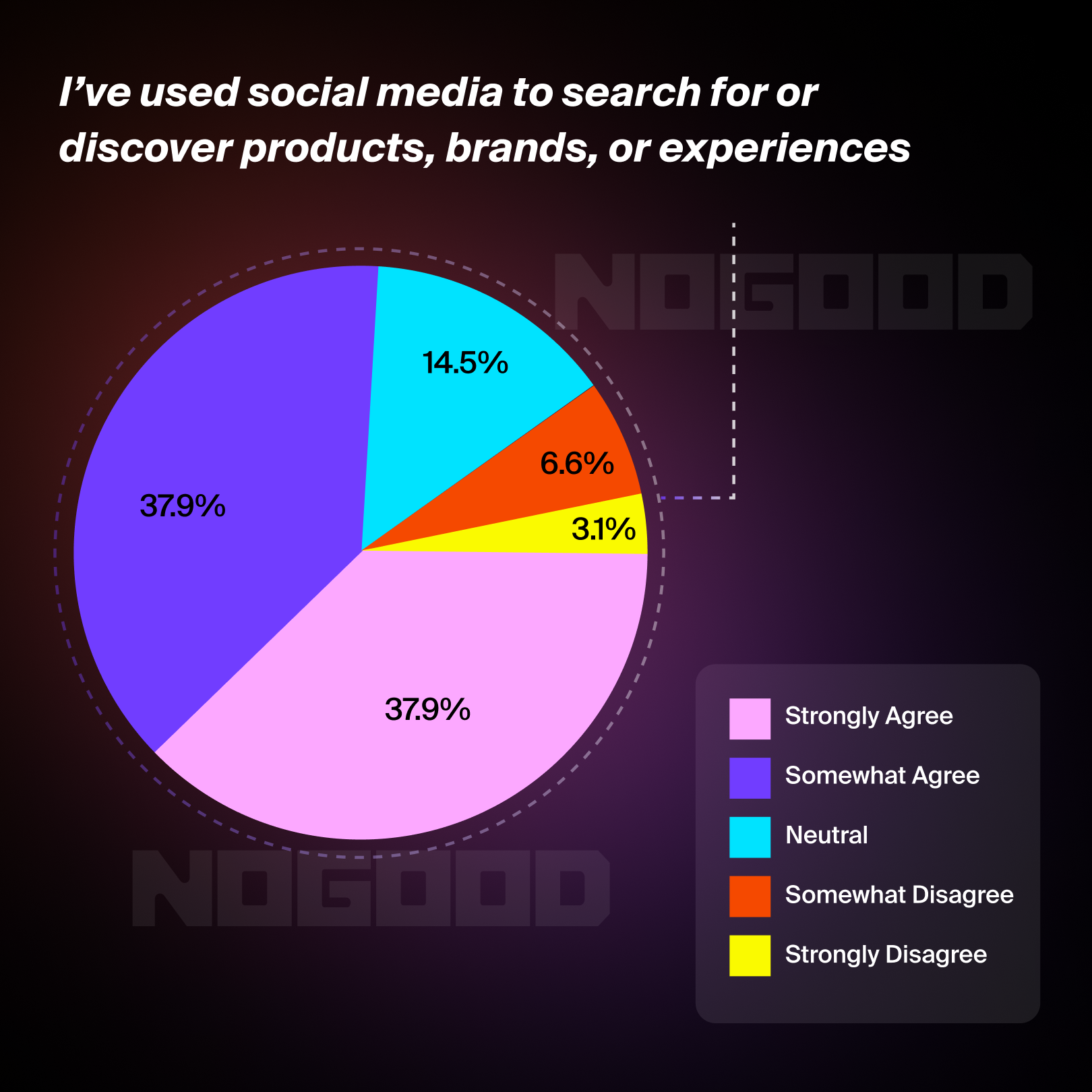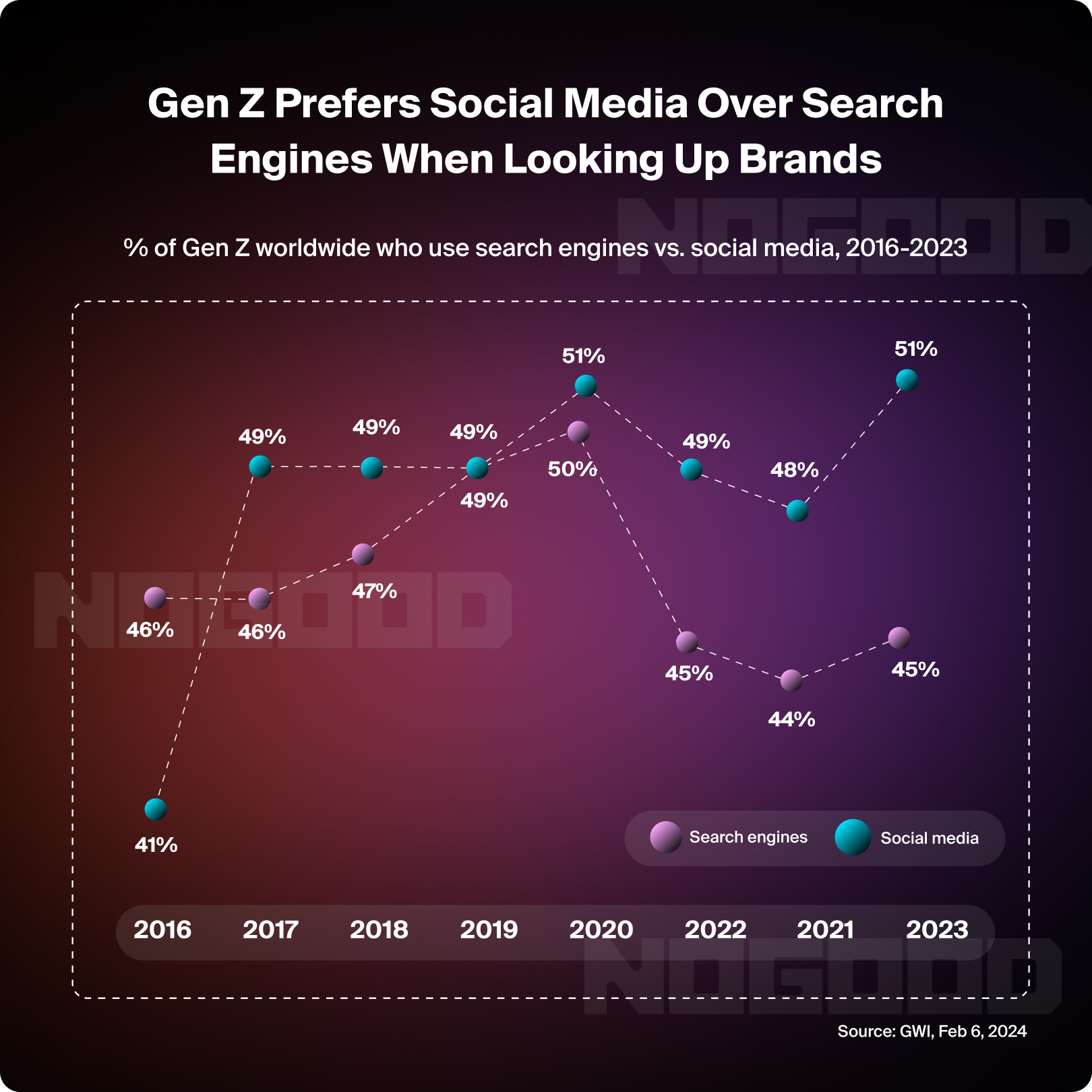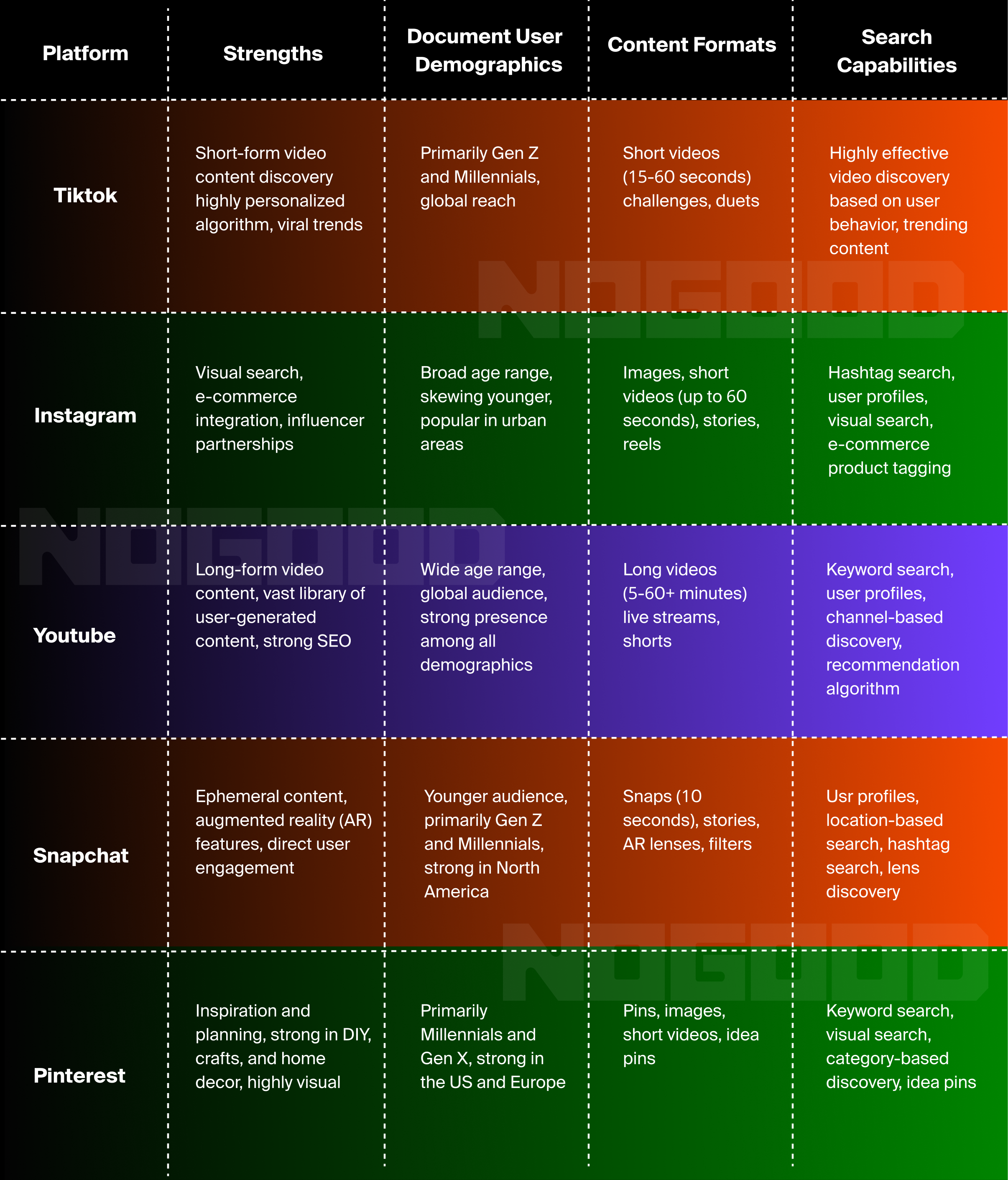Remember when “Googling” was the go-to method for finding anything online? Well, times are changing and fast. As a tech enthusiast who’s been tracking digital trends for over two decades, I’ve witnessed numerous shifts in how we seek and consume information. But the rise of social search? It’s a game-changer that’s reshaping the digital landscape at breakneck speed.
Picture this: A Gen Z user wanting to find the best ramen spots in town. Instead of typing a query into Google, they’re more likely to fire up TikTok or Instagram, scrolling through vibrant videos and authentic reviews from fellow food enthusiasts. This isn’t just a fleeting trend—it’s a fundamental shift in information discovery that’s sending ripples through the worlds of marketing, tech, and consumer behavior.
Those in our community remember when we released our first future of search report back in 2022, pointing out the rise of TikTok and the challenge it presents to Google, which was later confirmed by Google’s own search team.
In this deep dive, we’ll explore how social search has evolved over the past year with the introduction of Generative AI and platforms doubling down on search, why it matters so much (especially to younger generations), and what it means for brands trying to stay relevant and take advantage of emerging opportunities in a rapidly evolving space.
What is Social Search?
Social search integrates social signals, such as user recommendations, shares, likes, and comments, into search results. Unlike traditional search engines that rely on algorithms to rank web pages based on keywords and links, social search engines prioritize content that has been validated by users within a social network. This approach offers more personalized and relevant results based on the user’s social connections and interactions.

The Evolution of Social Search
In the past year, social search has undergone a significant transformation, primarily driven by the increasing use of platforms like TikTok, Instagram, and others. Here are some key developments:
- Algorithm Enhancements: Platforms have refined their algorithms to provide more accurate and personalized results. For instance, TikTok’s algorithm is renowned for its ability to surface highly relevant content based on user behavior and preferences.
- Influencers and creators Impact: Influencers play a crucial role in social search, with their content often ranking highly due to high engagement rates. This trend has grown stronger with the rise of micro-influencers who have more niche and engaged audiences.
- Integration with E-commerce: Social search is increasingly intertwined with e-commerce, allowing users to search for products directly within social platforms and make purchases without leaving the app.
- Visual and Video Search: There has been a shift from text-based search to visual and video search. Users are now more likely to search for content using images and videos, which is particularly evident on platforms like Instagram and TikTok.
How Social Search Differs from Conventional Search
Conventional search engines like Google and Bing rely on keyword matching, backlinks, and other SEO factors to rank content. In contrast, social search engines prioritize:
- User Engagement: Content with high engagement (likes, shares, comments) is ranked higher.
- Social Validation: Recommendations from users’ social networks play a crucial role in ranking.
- Real-Time Trends: Social search engines are more attuned to real-time trends and viral content, providing up-to-date results.
Search and The Power of Social Graph
Platforms like TikTok and Instagram leverage a social graph—a map of social connections and interactions—which significantly enhances search capabilities. This social graph allows for a high degree of personalization, as search results are tailored to the user’s social network, making the content more relevant and engaging. Users see results influenced by their friends, family, and influencers, increasing the trustworthiness and relevance of the information.
Credibility is elevated when content comes from within a user’s social network. Recommendations and content from friends or influencers are perceived as more authentic compared to anonymous sources, making users more likely to trust and act on them. Social interactions like likes, shares, and comments boost content visibility, creating a feedback loop where engaging content gains more visibility and further engagement.
The real-time nature of social search means trends and viral content surfaced quickly, providing users with current and popular information. This immediacy sets social search apart from traditional search engines, which often rely on static data. Overall, the social graph transforms search into a dynamic, interactive, and personalized experience, offering a distinct advantage over conventional search methods.
Rise of Social Search Among Gen Z
Gen Z, the digital native generation, has significantly influenced the rise of social search. According to Business Insider, 60% of Gen Z use Instagram for product discovery, and 40% of Gen Z prefer using TikTok and Instagram over Google for search (Google internal data).

Here’s why searching on social makes sense for them:
- Preference for Visual Content: Gen Z prefers visual content over text. They are more inclined to search for information through videos and images, making platforms like TikTok and Instagram their go-to sources.
- Trust in Peer Recommendations: This generation places high trust in peer recommendations and user-generated content. Social search aligns with this trust by showcasing content validated by their social circle.
- Instant Gratification: Gen Z expects quick and relevant results. Social search, with its emphasis on personalized and real-time content, meets this expectation effectively.
- Authenticity: User-generated content feels more genuine and relatable than polished marketing materials.
TikTok: The Rising Star of Social Search
TikTok’s ascent as a search engine has been meteoric. Its algorithm’s ability to surface relevant, engaging content has made it a formidable player in the search landscape. Here’s how:
- Algorithmic Precision: TikTok’s sophisticated algorithm tailors content to user preferences, making search results highly relevant.
- User Engagement: High levels of user engagement with content boost the visibility and credibility of search results.
- Visual-First Approach: TikTok’s highly engaging video-centric format aligns with how younger users prefer to consume information.
- TikTok Authentic: TikTok arguably led the way in the culture of social authenticity; its content feels more genuine and relatable than traditionally polished Instagramable content.
- Discoverability: TikTok’s algorithm excels at surfacing niche and trending content, often outperforming traditional search engines in certain categories.
- Short-Form Video Content: TikTok’s focus on short-form videos makes it an ideal platform for quick, engaging search results.
Generative AI Impact on Social Search
Generative AI is transforming social search by making it conversational, personalized, and incredibly user-friendly. Imagine chatting with an AI that feels like a knowledgeable friend, instantly providing detailed answers tailored to your questions. This natural interaction makes finding information feel less like a chore and more like a seamless conversation.
Personalization is where AI really shines. By analyzing your habits and preferences, it delivers search results that match your interests perfectly. No more wading through irrelevant content – the AI knows what you like and serves up the most engaging and relevant results. Over time, it gets even better at predicting what you’ll enjoy, creating a search experience that feels uniquely yours.
Content curation is another game-changer. AI sifts through vast amounts of data to highlight the best content, ensuring you always see the highest quality and most relevant information. This means less time searching and more time enjoying content that matters to you.
For brands, AI offers deep insights into user behavior, helping them create content that truly connects with their audience. It’s a win-win: users get the content they love, and brands engage more effectively. With AI delivering personalized, instant responses, users find everything they need right on their favorite platforms, reducing the need to turn to traditional search engines like Google. This shift not only enhances user experience but also keeps them engaged longer on social platforms.
Meta’s Inclusion of Llama 3 in the Search Bar
Meta’s integration of Llama 3 into its search functionality across platforms with over 3 billion users marks a significant milestone. Here’s why it matters:
- Enhanced Search Accuracy: Llama 3’s advanced AI capabilities improve the accuracy and relevance of search results.
- Unified Experience: Users get a seamless search experience across Meta’s platforms, including Facebook and Instagram.
- AI-Powered Insights: Brands gain deeper insights into user behavior and preferences, helping them tailor their content and marketing strategies.
Social Search Impact on Brands
The shift towards social search has profound implications for brands:
- Content Strategy: Brands need to focus on creating engaging, shareable content that resonates with their target audience.
- Influencer Partnerships: Collaborating with influencers who have high engagement rates can boost a brand’s visibility in social search results.
- Real-Time Engagement: Brands must stay attuned to real-time trends and be ready to engage with users promptly.
Comparative Analysis of Social Search Platforms:

Adapting to the Changing World of Social Search
Brands can adapt to the evolving landscape of social search by:
- Leveraging Creators as part of GTM strategy:: Partner with creators and influencers to create authentic, engaging content that can boost visibility in social search results.
- Creating Shareable Content: Focus on creating high-quality, visually appealing content that encourages user interaction.
- Utilizing AI Tools: Use AI tools to analyze trends, generate content, and personalize user interactions.
- Engaging in Real-Time: Monitor social trends and engage with users in real-time to stay relevant and visible.
- Optimizing for Visual Search: Optimize content for visual and video search by using relevant hashtags, keywords, and engaging visuals.
Practical Strategies for Social Search Optimization
As social search continues to gain prominence, optimizing your content for these platforms becomes crucial. Here’s a practical, step-by-step approach to enhance your brand’s visibility in social search results:
- Keyword Research for Social Platforms
- Use platform-specific tools like TikTok’s Keyword Insights or Instagram’s Explore page to identify trending topics and hashtags.
- Analyze competitor content to spot frequently used keywords in your niche.
- Pay attention to how your target audience phrases their queries on social platforms.
- Optimize Content Descriptions and Captions
- Front-load key information and keywords in the first few lines.
- Use a mix of broad and niche hashtags (5-10 for Instagram, 3-5 for TikTok).
- Include relevant keywords naturally throughout the caption.
- Create Search-Friendly Video Content
- Start videos with a hook that includes your main keyword or topic.
- Use on-screen text to highlight key points and include searchable terms.
- Create content that directly answers common questions in your niche.
- Leverage User-Generated Content (UGC)
- Encourage customers to create content using your branded hashtag.
- Repost and engage with UGC to boost visibility and authenticity.
- Run contests or challenges that prompt users to create searchable content related to your brand.
- Optimize Your Brand Profile
- Use relevant keywords in your bio, profile name, and username.
- Keep your profile public and use a clear, recognizable profile picture.
- Include a link to your website or a landing page with additional resources.
- Engage Actively and Consistently
- Post regularly (aim for at least 3-5 times per week on major platforms).
- Respond promptly to comments and messages to boost engagement.
- Participate in relevant conversations using trending hashtags.
- Utilize Platform-Specific Features
- For TikTok: Use trending sounds, participate in challenges, and create content for the “For You” page.
- For Instagram: Utilize Reels, Stories, and IGTV to diversify your content and increase discoverability.
- For Pinterest: Create vertical images with text overlays and detailed descriptions.
- Implement Cross-Platform Strategies
- Adapt successful content from one platform to suit others.
- Use consistent branding and messaging across all platforms to reinforce brand identity.
- Cross-promote content to drive traffic between your social profiles.
- Monitor and Analyze Performance
- Use built-in analytics tools to track which content performs best in search.
- Pay attention to metrics like watch time, engagement rate, and follower growth.
- Regularly review and adjust your strategy based on these insights.
- Stay Updated with Platform Changes
- Follow official platform blogs and announcements for algorithm updates.
- Experiment with new features early to gain a potential advantage in visibility.
- Attend webinars or courses offered by platforms to stay ahead of best practices.
By implementing these practical steps, brands can significantly improve their visibility in social search results. Remember, social search optimization is an ongoing process. The key is to remain agile, consistently produce high-quality, relevant content, and always keep your audience’s needs and preferences at the forefront of your strategy. This approach to social search optimization not only helps in improving discoverability but also enhances overall engagement and brand loyalty.







